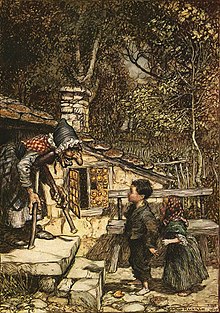| Hansel and Gretel | |
|---|---|
 The witch welcomes Hansel and Gretel into her hut. Illustration by Arthur Rackham, 1909. | |
| Folk tale | |
| Name | Hansel and Gretel |
| Aarne–Thompson grouping | ATU 327A |
| Region | German |
| Published in | Kinder- und Hausmärchen, by the Brothers Grimm |
"Hansel and Gretel" (/ˈhænsəl, ˈhɛn- ... ˈɡrɛtəl/; German: Hänsel und Gretel [ˈhɛnzl̩ ʔʊnt ˈɡʁeːtl̩])[a] is a German fairy tale collected by the Brothers Grimm and published in 1812 as part of Grimms' Fairy Tales (KHM 15).[1][2] It is also known as Little Step Brother and Little Step Sister.
Hansel and Gretel are siblings who are abandoned in a forest and fall into the hands of a witch who lives in a bread,[3] cake, and sugar house. The witch, who has cannibalistic intentions, intends to fatten Hansel before eventually eating him. However, Gretel saves her brother by pushing the witch into her own oven, killing her, and escaping with the witch's treasure.[4]
Set in medieval Germany, "Hansel and Gretel" has been adapted into various media, including the opera Hänsel und Gretel by Engelbert Humperdinck, which was first performed in 1893.[5][6]
Cite error: There are <ref group=lower-alpha> tags or {{efn}} templates on this page, but the references will not show without a {{reflist|group=lower-alpha}} template or {{notelist}} template (see the help page).
- ^ Harries 2015, p. 225.
- ^ Ashliman, D. L. (2011). "Hansel and Gretel". University of Pittsburgh.
- ^ Heiner, Heidi Anne (2021). "Hansel & Gretel Annotations". Sur La Lune.
- ^ Zipes 2013, p. 121.
- ^ Opie & Opie 1974, p. 236.
- ^ Harries 2015, p. 227.